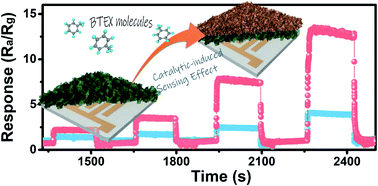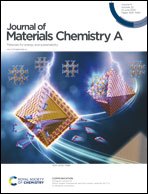The catalytic-induced sensing effect of triangular CeO2 nanoflakes for enhanced BTEX vapor detection with conventional ZnO gas sensors†
Abstract
It is incredibly difficult to detect inert gaseous chemicals such as BTEX (i.e. benzene, toluene, ethylbenzene and xylene) vapors using conventional metal–oxide–semiconductor (MOS) gas sensors. CeO2 is a widely used catalyst for cracking benzene and its homologues. However, the CeO2 catalyst cannot be directly added into MOS-based materials for sensing applications due to its insulating characteristics. Herein, a novel bi-layer sensing structure is proposed for trace BTEX detection, where the insulated CeO2 catalyst is coated onto the top-surface of a ZnO sensing layer. Our study verifies that the top-layer of the CeO2 catalyst only has a negligible influence on the resistance of the bottom ZnO sensing layer. To achieve high sensing performance for trace-level BTEX, two nanomaterials, triangular CeO2 nanoflakes and nano-porous ZnO, are used to construct the bi-layer gas sensor. The fabricated ZnO–CeO2 sensor exhibits satisfactory sensing performance for BTEX vapors and its limit of detection (LOD) for toluene reaches 10 ppb. The catalytic-induced cracking mechanism of the CeO2 nanoflakes is further revealed by online mass spectrometry (online MS).



 Please wait while we load your content...
Please wait while we load your content...